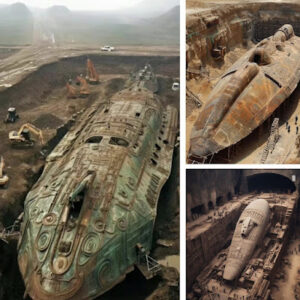For over 3,000 years, the Tomb of King Solomon, one of the most elusive and mysterious burial sites in history, has remained hidden beneath layers of time and legend. Known as a king of immense wisdom and wealth, the story of Solomon has captivated scholars, archaeologists, and treasure hunters alike. Yet, despite countless searches, no one has definitively located the tomb—until now. Recent discoveries in a remote region of the ancient city of Jerusalem have unveiled new evidence that could finally shed light on its location. But the most shocking revelation isn’t just the discovery of the tomb—it’s what was found inside.

In a groundbreaking excavation, researchers uncovered artifacts and inscriptions that challenge everything we thought we knew about Solomon’s reign and his legendary wealth. Among the finds were rare treasures, including intricately carved gold and silver items, and a series of stone tablets that contained cryptic messages potentially linked to lost knowledge of ancient civilizations. These artifacts, believed to have been buried alongside the king, suggest that King Solomon’s tomb was not merely a burial site but a repository of unimaginable secrets—some of which may have been hidden on purpose to protect a sacred legacy.

One of the most astonishing revelations is the discovery of a complex, previously unknown form of ancient writing on a set of stone tablets found near the tomb. These inscriptions, which appear to be in a language related to ancient Hebrew but containing strange symbols, may hold the key to unlocking forgotten knowledge about early civilizations and their connections to the divine. Experts are working tirelessly to decipher the writings, which could lead to a better understanding of Solomon’s role in the ancient world, his relationship with other civilizations, and the hidden truths he may have kept from the public.
The location of Solomon’s tomb itself raises further questions. Was it hidden intentionally by the ancient Israelites to protect it from invaders? Or was its concealment part of a broader attempt to preserve the king’s memory in ways that were not immediately apparent? Historical records suggest that Solomon’s reign was marked by great achievements, including the construction of the First Temple in Jerusalem, one of the most significant structures in ancient history. However, as new evidence surfaces, some scholars are beginning to question whether the tomb holds additional clues to the king’s mystical and spiritual beliefs, which were far ahead of his time.
Another layer to this mystery lies in the possibility that King Solomon’s tomb could hold connections to other legendary figures and ancient civilizations. Many researchers have long speculated that Solomon’s wisdom was not just a product of his time but was influenced by knowledge passed down from earlier cultures, possibly even extraterrestrial sources. Could these revelations be the missing link that connects King Solomon to ancient technologies and mysteries that have puzzled historians for centuries?
The shocking truth behind King Solomon’s tomb is far from clear, but one thing is certain: the discovery opens up new avenues for exploration into the world of ancient history and the secrets it holds. As researchers continue their work, we may be on the brink of uncovering truths that could alter our understanding of Solomon’s reign, his influence on the ancient world, and the hidden knowledge that he may have guarded with his life. The tomb of King Solomon, it seems, is not only a final resting place but a key to a deeper, more profound mystery waiting to be revealed.


